#The Holy Graal
Text

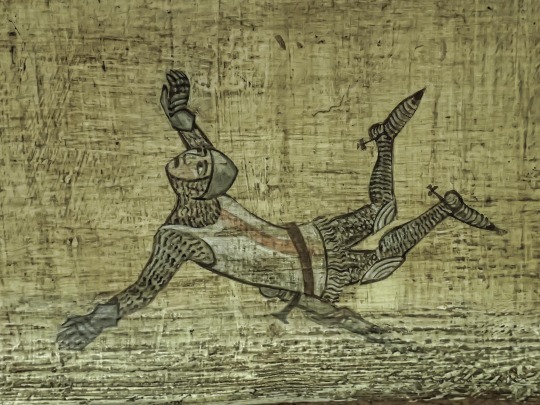

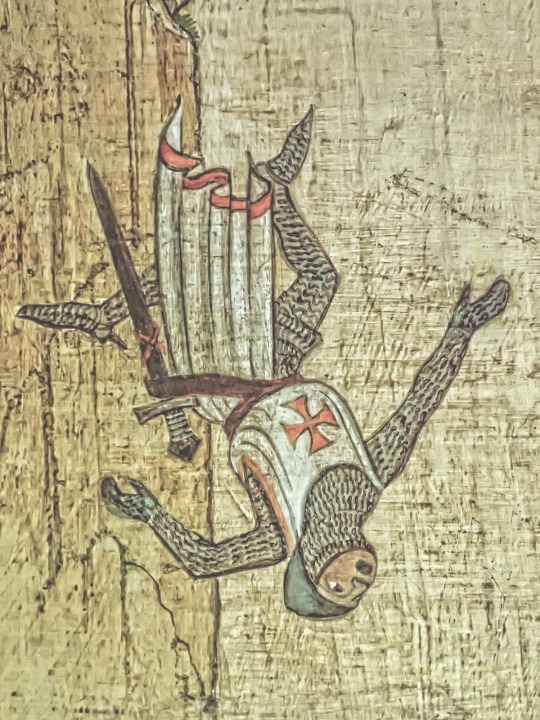
Knights attempting a Leap of Faith to reach the Holy Grail
— Indiana Jones and the Last Crusade (1989)
#knights#knight#holy grail#grail#graal#indiana jones#indiana jones and the last crusade#knights templar#medieval#middle ages#chivalry#art#crusades#crusaders#templars#templar#crusade#crusader#history#film#films#cinema#religion#arthurian#esoteric#christian#christianity#christendom#religious#chain mail
689 notes
·
View notes
Text
Le bail du Graal dans Kaamelott me FASCINE you don't even know. C'est une forme de paganisme tellement méga poussée et pourtant les persos se considèrent christianisés. C'est trop intéressant pcq en plus, le syncrétisme bizarre présenté dans la série n'est même pas historique (mais alors PAS DU TOUT).
J'explique : le concept du Graal dans Kaamelott, c'est que cet objet est supposé être "la lumière pour tous les peuples," qui va apporter la vie éternelle et le salut aux hommes right? Càd les attributs de Jésus dans les évangiles; attributs qui lui sont exclusivement propres.
Ptit récap aux oignons pour ceux qui connaissent pas :
"En [Jésus] nous avons la rédemption par son sang, la rémission des péchés, selon la richesse de sa grâce." (Ephésiens 1:7)
"Jésus leur parla de nouveau, et dit: Je suis la lumière du monde; celui qui me suit ne marchera pas dans les ténèbres, mais il aura la lumière de la vie." (Jean 8:12)
"Au commencement était la Parole, et la Parole était avec Dieu, et la Parole était Dieu. Elle était au commencement avec Dieu. Toutes choses ont été faites par elle, et rien de ce qui a été fait n'a été fait sans elle. En elle était la vie, et la vie était la lumière des hommes." (Jean 1:4)
"Car il y a un seul Dieu, et aussi un seul médiateur entre Dieu et les hommes, Jésus-Christ homme, qui s'est donné lui-même en rançon pour tous." (1 Timothée 2:5-6)
"Il est lui-même une victime expiatoire pour nos péchés, non seulement pour les nôtres, mais aussi pour ceux du monde entier." (1 Jean 2:2)
"Car Dieu a tant aimé le monde qu'il a donné son Fils unique, afin que quiconque croit en lui ne périsse point, mais qu'il ait la vie éternelle." (Jean 3:16)
"Mes brebis entendent ma voix; je les connais, et elles me suivent. Je leur donne la vie éternelle; et elles ne périront jamais, et personne ne les ravira de ma main." (Jean 10:27-28)
On voit bien que 1) tout ça, c'est exactement comment les persos parlent du Graal, donc comme si c'était Jésus lui-même, et 2) y a rien dans le texte biblique qui permette que ces caractéristiques de Jésus soient conférées à un objet. Mais c'est intéressant pcq le sacrifice de Jésus est souvent, par métonymie, appelé son sang (versé pour nous). D'où la déformation possible - si on venait à prendre 'sang' littéralement, d'un coup on aurait besoin d'être en présence physique du sang de Jésus pour être sauvé, plutôt que d'avoir foi en son sacrifice. Et du coup, puisque le sang ne peut pas exister par lui-même, il faudrait chercher l'object qui l'a contenu. Et du coup, l'objet devient l'objet de la quête.
(Sauf que cette coupe qui contient le sang de Jésus ? Spirituellement, c'est n'importe quelle coupe utilisée pour boire le vin de la sainte-cène, càd le pain et le vin partagés entre chrétiens en souvenir du sacrifice. Luc 22:19-20. Le rêve d'Arthur, où il s'imagine que Perceval paume le Graal dans les coupes de la taverne ? Bah c'est plus proche de la Bible finalement. Mais comme le Graal, c'est ramener sur le plan matériel des réalités qui le transcendent, ça devient le recipient de la première sainte-cène littéralement utilisé pour récolter le sang de Jésus.)
Et du coup cette quête c'est la chose la moins chrétienne qui soit pcq :
- tu mets la grace universelle et sans limite du Dieu créateur dans un objet symbolique (définition de l'idolâtrie)
- tu remplaces un salut surnaturel et transcendant qui réconcilie les humains avec le divin par un salut matériel basé sur l'adoration d'une chose terrestre (la foi spirituelle est replacée par la religion/les rites)
- et tu prends un message clair et sans ambiguïté ('Jésus est mort et ressuscité pour le péché de ce monde, croyez et soyez sauvés') par une quête abstraite, apparemment impossible, 5 siècles après Jésus (donc personne n'a été sauvé entre temps, alors que sur la croix, Jésus a dit "tout est accompli").
Le Graal est flou, personne sait où il est, ce que c'est, s'il existe, même pas les dieux - ce qui est à l'opposé de Jésus, incarnation de la Parole (càd de la vérité/du sens/de la clarté). Rien dans le concept même du Graal ne colle avec la Bible. (Surtout pas l'interprétation d'Arthur, que Jésus est mort pour que tous soient coupables - pcq pour le coup oui, si la seule chose que sa mort donne à l'humanité c'est une Quête impossible pour le salut, Il a juste condamné tout le monde; sauf que c'est absolument pas ce qui est dit dans la Bible.)
D'où ça vient, alors ? Comment est-ce que cette croyance est apparue dans le monde de Kaamelott ?
Dans la vraie vie, l'apparition du Graal dans les légendes arthuriennes vient de fanfics de la mythologie celte mises à la sauce catho, mais ça s'est fait... au XIIème siècle !! (Plus exactement, le Graal lui-même est introduit au XIIème siècle, recyclé du concept irlandais du chaudron d'immortalité, et il n'est appelé une relique chrétienne qu'au XIIIème siècle.) Ce mélange est un énorme double retcon, en gros. Le Graal n'existait pas chez les celtes du 5ème siècle, ni en temps qu'objet de culte païen, ni en temps qu'objet païen adapté au christianisme.
Pareil avec le Saint-Suaire - la première fois qu'un texte quelconque en parle, c'est au XIVème siècle. (Fun fact : les clous, pas contre, y a des refs qui datent du 4ème siècle.)
Donc en gros, dans Kaamelott, les persos ont des croyances qui sont impossibles pour leur époque. Les anachronismes sont pas méga surprenants, vu par exemple la jeunesse d'Arthur dans une Rome des années 460 où le christianisme est à peu près aussi mainstream que le pastafarisme. Historiquement, Rome était officiellement 100% chrétienne depuis environ 140 ans. C'était plus Spartacus et Astérix.
Mais encore une fois, outre les anachronismes... le Graal vient d'où, dans Kaamelott ? Puisque dans la vraie vie, ce sont des chrétiens qui ont pompés des vieilles légendes celtes pour le créer, pas des celtes qui ont déformés leurs propres mythes quand leurs propres cultes existaient encore.
Pour moi, tout ce bazar justifie une interprétation clairement pas voulu par Astier - que 'in-universe,' on peut voir la Quête du Graal dans Kaamelott comme une invention par les dieux celtes non-sanctionné par le "Dieu unique," dans un pari désespéré pour que leurs cultes disparaissaient pas.
J'irais même jusqu'à dire qu'on peut défendre l'idée que Dieu est carrément contre et qu'Arthur a en fait deux destinées séparées : une avec Excalibur et le Graal, d'après les dieux celtes, suivant les lois et la morale celte, et une selon Dieu, avec la fidélité à Guenièvre notamment.
Pour étayer ça, y a le fait que la Dame du Lac - qui est très ouvertement celte, envoyée et porte-parole des dieux celtes - est une force moteur de la Quête du Graal sans jamais être capable d'expliquer pourquoi Dieu délègue. Y aussi que les ordonnances des dieux celtes, directement liées au succès de la quête, sont souvent à l'opposé exacte de la loi biblique (ex : Arthur commet une double faute en épousant Mevanwi et en l'épousant sans tuer Karadoc, alors que dans l'histoire de David, le plus grand des deux péchés n'est pas l'adultère mais le meurtre d'Uri, le mari de Bathshéba.)
Il y a bcp, bcp d'autres trucs, mais ce post est bcp trop long donc je détaillerai ça une autre fois.
27 notes
·
View notes
Text
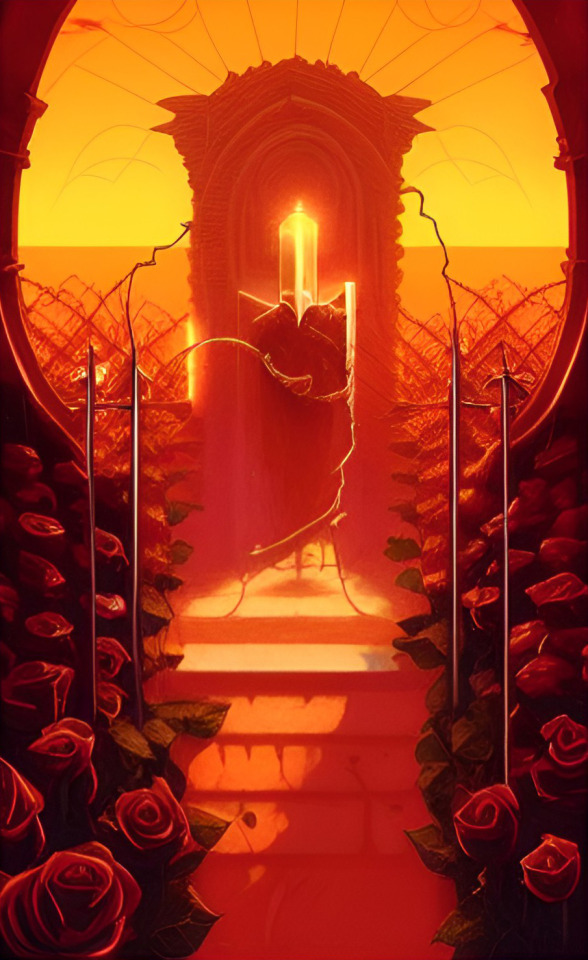
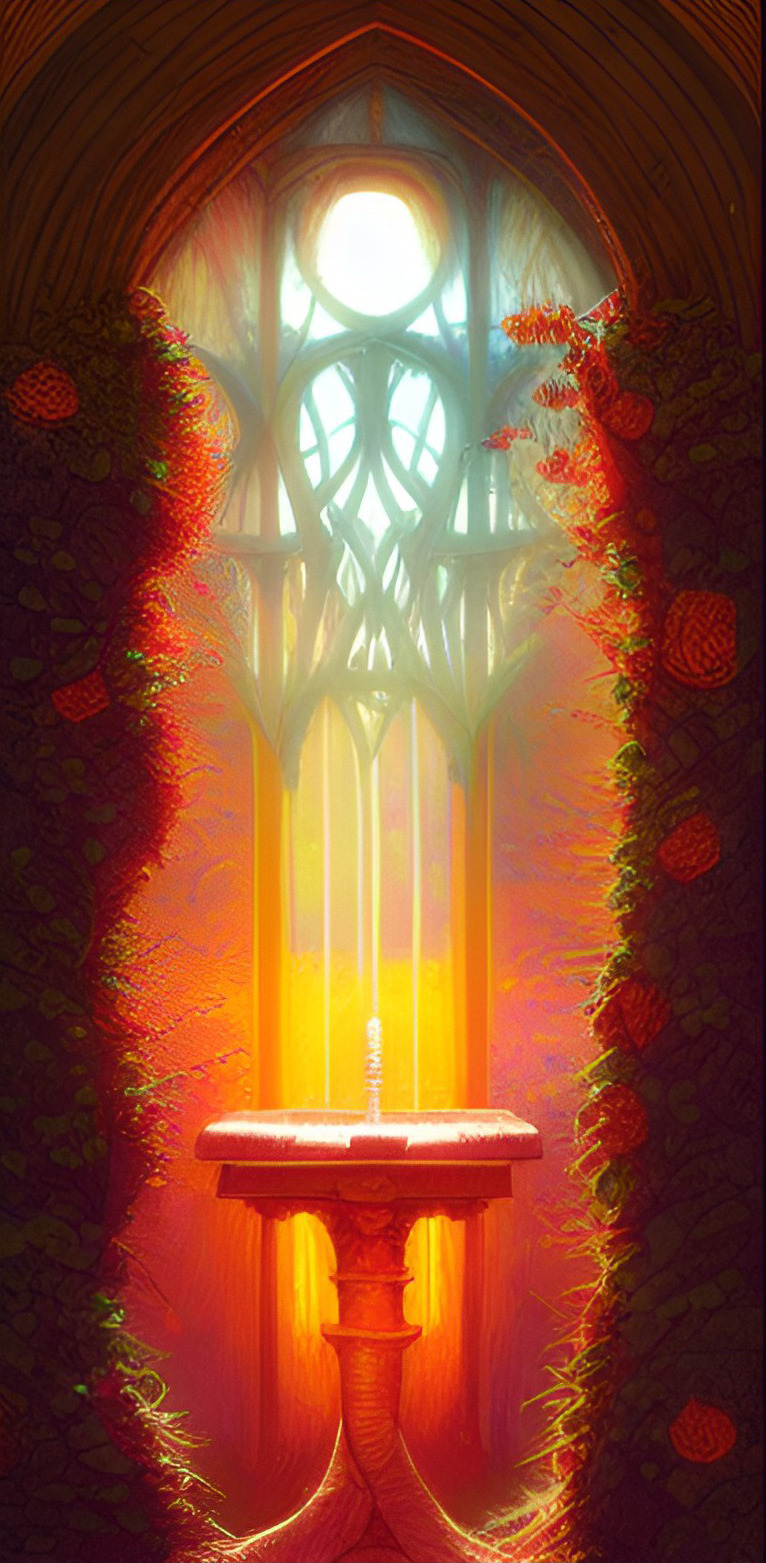
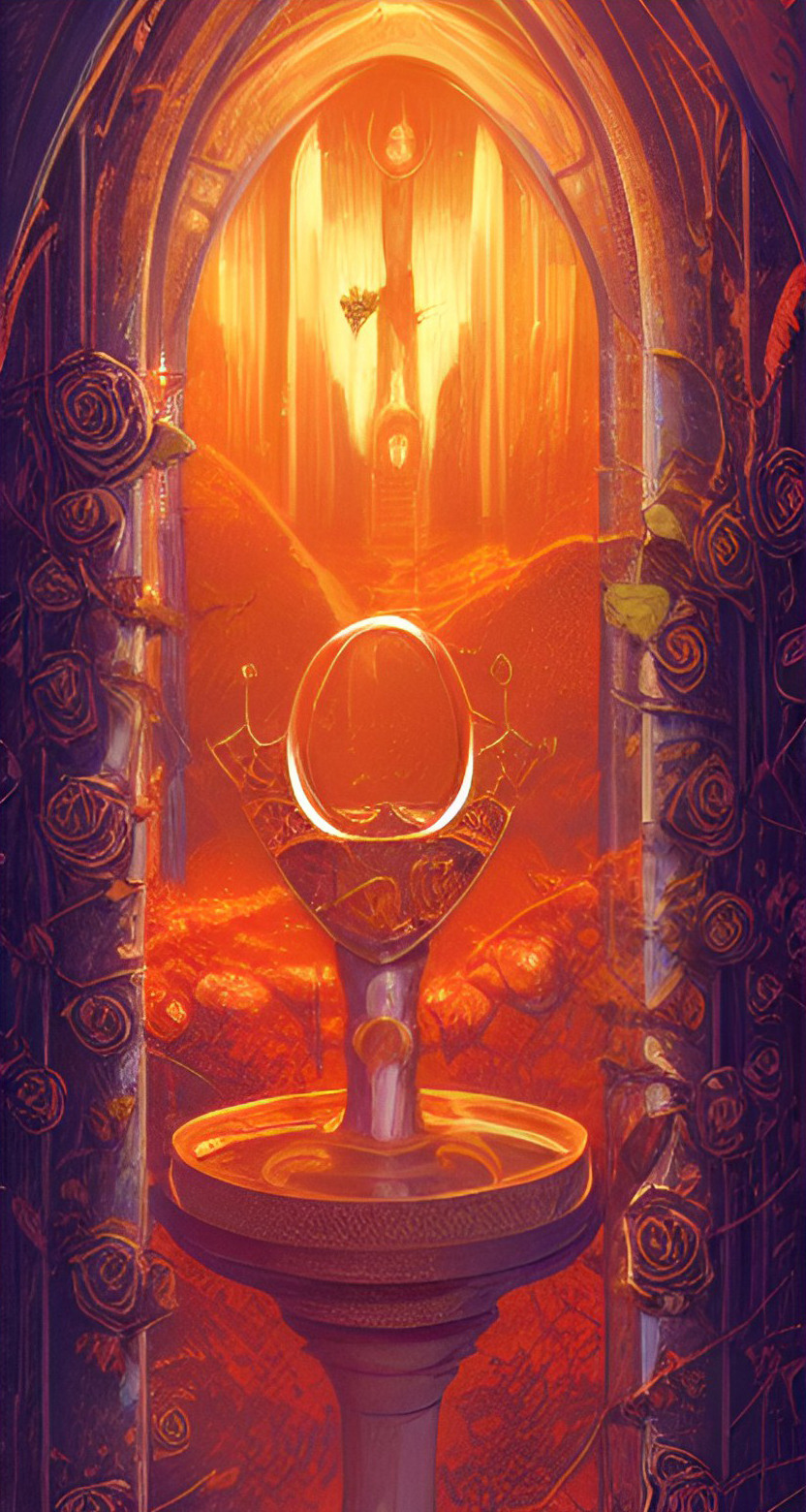
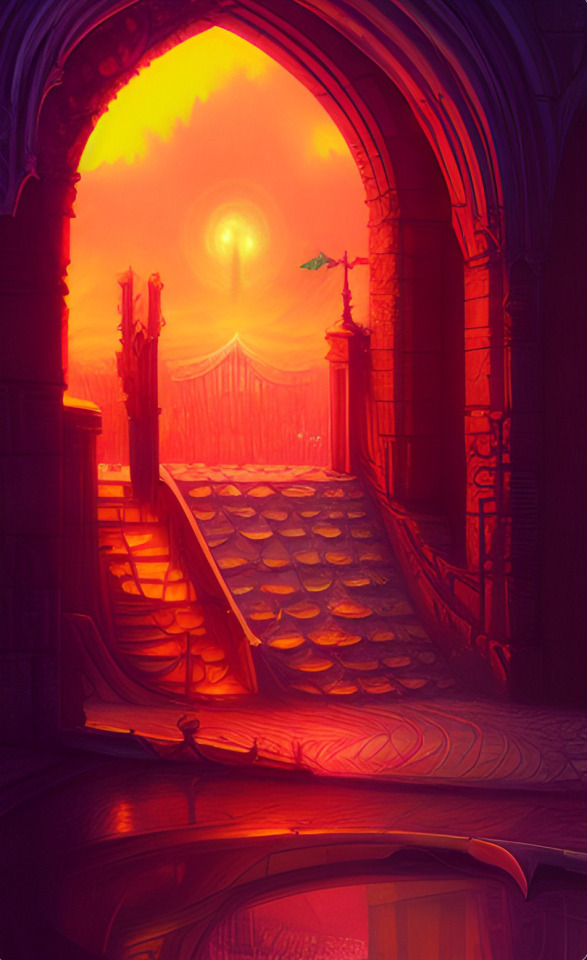
Les Contes du Saint Graal #3
31 notes
·
View notes
Text
Monty Python e il Sacro Graal
Benvenuti o bentornati sul nostro blog. Nello scorso articolo abbiamo deciso di parlare di una pellicola sud coreana diretta da un regista eccezionale, Park Chon-Wook, una pellicola davvero molto particolare ossia I’m a Cybog, but that’s OK. La storia parla di questa ragazza che un giorno viene ricoverata in manicomio dopo aver provato a mettersi dei cavi elettrici dentro il braccio. Il motivo…
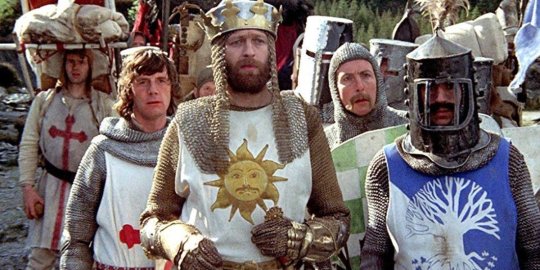
View On WordPress
#adventure#avventura#comedy#comico#commedia#E ora qualcosa di completamente diverso#Eric Idle#film#flusso di coscienza#Graham Chapman#Inghilterra#John Cleese#Michael Palin#Monty Python#Monty Python and the Holy Grail#Monty Python e il Sacro Graal#Monty Python&039;s Flying Circus#movies#Neil Innes#Python (Monty) Pictures#Re Artù#Recensione#Recensione film#Santo Graal#Sir Bedevere#Sir Galahad#Sir Lancillotto#Sir Robin#Terry Gilliam#Terry Jones
2 notes
·
View notes
Video
youtube
Sfântul Graal din Valencia/The Holy Grail of Valencia
0 notes
Text
Perlesvaus (Evans translation)
So I'm taking another stab at reading the Sebastian Evans translation of Perlesvaus, for... reasons. Or the High History of the Holy Graal, as he titles it -- funnily enough, the people who put out this reprint apparently looked at the title, said "we're not doing that", and spelt it Grail on the cover.
Despite the bizarre choices in diction, it's still pretty fun, and I want to share some particularly entertaining bits of this text with y'all. (For those of you who aren't up on the two different translations of Perlesvaus and don't know what I mean by "bizarre choices", the Evans translation is from 1898 but pretending to be from, like, 1498.)
N.B.: Marginal notes in red are from the last time I tried this -- they stop showing up roughly a quarter of the way through the book, because that's when I decided to buy the Bryant translation instead.

I just find this funny because "who cares?" strikes me as such a modern thing to say. To me it is a phrase that seems most natural coming from a teenage character in late-20th-century media. But nope. "Who careth?"

This is here just for the bizarre scene. We have three women coming into the throne room (riding mules directly into the building, by the way). One is carrying a severed head decorated with silver and gold. Another has "a pack trussed behind her with a brachet thereupon" -- you can see from the notes that I had to look up "brachet", found out it was an old word meaning roughly "female scent-hound", and then had the mental image of this woman carrying around a beagle in a baby-bjorn.

Again something I find funny. Gawain just leaping through the air to interpose himself between the horses and this hermit, like he's trying to take a bullet for them. This is entirely because he is 100% certain the hermit will handle the saddles incorrectly, and when the hermit assures him he actually does know how this stuff works, Gawain calms down & lets him do it.

This is, for my money, one of the funniest things in all of Perlesvaus, which is saying something because it is a bonkers text. This lady rolls up and provides that description, and the hermit recognizes who she's talking about. Like, "oh yes I did see a knight with a heart of steel and the navel of a virgin". I want to give this description to a sketch artist. (I kind of want to throw it at an AI just to see what it comes up with, but you know. I don't want to encourage the machines.)

This time I'm nit-picking the translation, because that strikes me as a misplaced modifier. Obviously it's meant that Gawain is unaware of events, but the sentence is constructed to make it sound like it's referring to the building itself, which is of course unaware because it's a building and isn't aware of anything. (Also, side note, I like the phrase "as methinketh!")


One more, and I'm leaving this for now...

Here is a case where I was going to complain, but on further examination, I must hand it to Evans. I assumed that he was just randomly archaizing, but I looked it up after uploading this photo, and according to the OED, this was a valid alternate spelling of sovereign from the 17th to the 19th century. (Interestingly, the latest attested example on the OED is from 11 years before this translation was published, meaning this is evidence it was in use slightly longer than the OED entry would suggest -- does anyone know if there's still a way to submit instances of a word to the OED?)
156 notes
·
View notes
Text
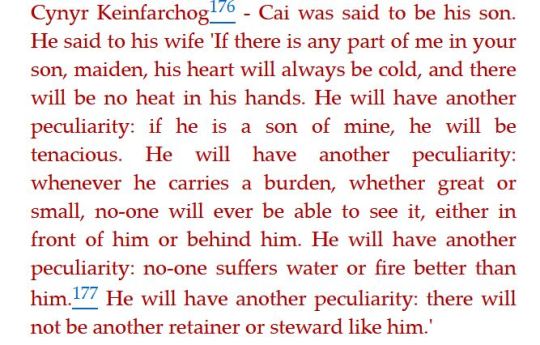




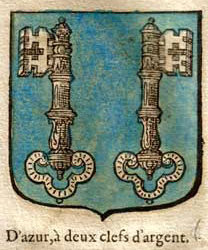
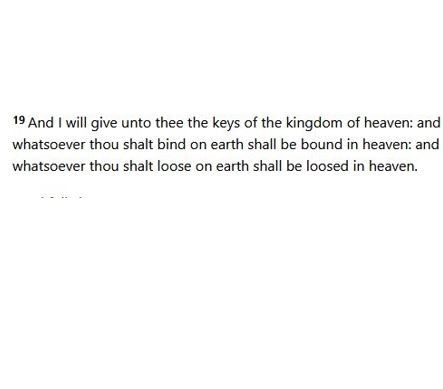

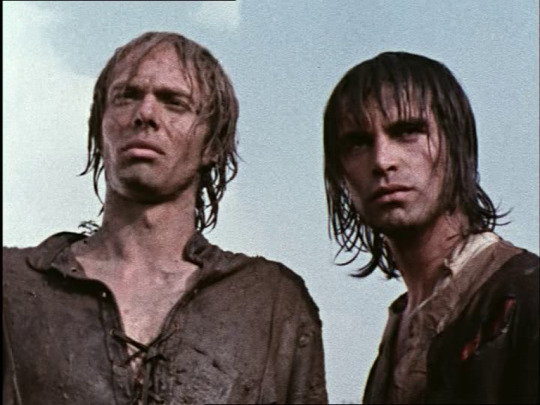






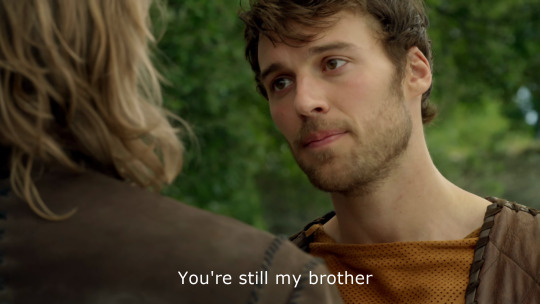


for @queer-ragnelle May Day Parade. May 17-21: Grumpy Month of Kay {Seneschal Celebration}
I have been here since before you became yourself: a collection of Kays (and Arthurs)
Chulhwch and Olwen / Camelot (2011) ep. 1 / Vulgate Cycle: The Story of Merlin / La Morte D'Arthur (Sir Thomas Malory) / The Once and Future King, book 1 The Sword in the Stone (TH White) / Sir Kay's coat of arms / Matthew 16:19 / Under cover of darkness (The Strokes) / Arthur of the Britons (1972) ep. 3 / Vulgate Cycle / Camelot (2011) / Icarus (The Crane Wives) / Idylls of the queen (Phyllis Ann Karr) / Hey Brother (Aviicii) / The High History of the Holy Graal (aka Perlesvaus), trans. Sebastian Evans / Camelot (2011) / Alliterative Morte Arthure, trans. Richard Scott-Robinson / Icarus (The Crane Wives)
#may day parade#arthuriana#sir kay#mine#i'm obsessed with arthuriana brothers you don't know how much#anyways here it is!!! I know st peter kay parallelisms something something but i can't articulate ok just read matthew 16 17-20#if i could make gifs i'd put one wih kay and arthur fighting dirty in arthur of the britons. instead you get a screencap!#also IGNORE the context of the perlesvaus like i did please and thank you (it's all st peter parallelisms until it starts being#judas parallelisms i guess but back to the thing ignore the contents of the perlesvaus for this post <3)#as an Estremely Tired eldest daughter who also works in administration for a living i feel kay the seneschal in my BONES
60 notes
·
View notes
Text
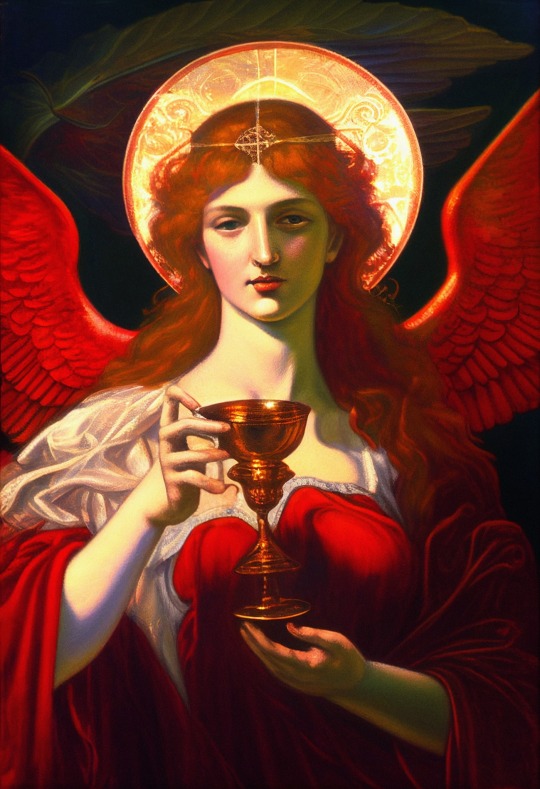
The Graal of Babalon
Talon Abraxas
Babalon is referred to as the Scarlet Woman, the Great Mother, and the Mother of Abominations. Her godform is that of a sacred whore, and her primary symbol is the Chalice or Graal. Her consort is Chaos, the “Father of Life” and the male form of the Creative Principle. Babalon is often described as being girt with a sword and riding the Beast, with whom Aleister Crowley personally identified. As Aleister Crowley wrote, “She rides astride the Beast; in her left hand she holds the reins, representing the passion which unites them. In her right she holds aloft the cup, the Holy Grail aflame with love and death. In this cup are mingled the elements of the sacrament of the Aeon” (Book of Thoth). In a more general sense, Babalon represents the liberated woman and the full expression of the sexual impulse.
As the Great Mother
Within the Gnostic Mass, Babalon is mentioned in the Gnostic Creed:
And I believe in one Earth, the Mother of us all, and in one Womb wherein all men are begotten, and wherein they shall rest, Mystery of Mystery, in Her name BABALON.
Babalon is identified with Binah on the Tree of Life, the sphere that represents the Great Sea and the mother-goddesses Isis, Bhavani, and Muat. Moreover, she represents all physical mothers. Sabazius and Helena (1998) write:
BABALON, as the Great Mother, represents MATTER, a word which is derived from the Latin word for Mother. She is the physical mother of each of us, the one who provided us with material flesh to clothe our naked spirits; She is the Archetypal Mother, the Great Yoni, the Womb of all that lives through the flowing of Blood; She is the Great Sea, the Divine Blood itself which cloaks the World and which courses through our veins; and She is Mother Earth, the Womb of All Life that we know.
22 notes
·
View notes
Text
Arthurian myth: Merlin (2)
A continuation of the loose translation of the "Merlin" article by Yves Vadé for the "Dictionnaire des Mythes Littéraires".
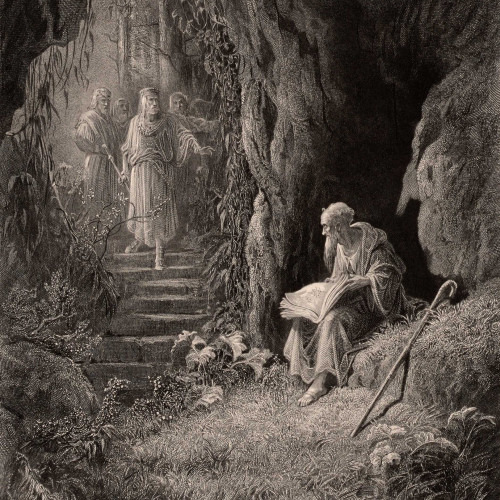
II/ Merlin in the Arthurian literature
As early as 1155, the Normand writer Wace transposed, for Alienor of Aquitaine, the “Historia Regum Britanniae” in French verse, in his “Roman de Brut”. He adds to the work the episode of the creation of the Round Table by Arthur, of whom Merlin will later become the prophet and the agent.
Merlin was barely mentioned by Chrétien de Troyes ; it is with Robert de Boron that he truly became the inspiration of the Grail’s knighthood. His work in verse, that contained at least the three romans known as “Joseph of Arimathea”, “Merlin” and “Perceval”, is partially lost in its original version, and it maybe even was unfinished. However, the prose translation of the “Merlin” was preserved, and seems to be quite faithful to Boron’s poem. The beginning of the roman takes back the motif of Merlin being born of an incubus demon, but it is now placed within a greater theological context: the demons wishes to produce an Antichrist, born of a virgin just like the Christ, in order to counter the Holy Incarnation. A demon managed, after some difficulties, to trick an honest young girl, but she immediately confessed her sin and she had the child baptized. From his father, the devil, Merlin received the knowledge of the entire past; and to counter this gift, God gave him the power to know the future. As such, Merlin is born with an universal knowledge. He uses it in the first months of his life to save his mother, threatened with burning at the stake ; then, at seven years old, he reveals to the usurper Vertigier the existence of the two dragons hidden under the foundations of his tower. He also reveals their meaning: the red dragon (Vertigier) will be killed by the white dragon (the young princes Pendragon and Uter, sons of the king Constant). Uter became king, and Merlin his advisor. He allows him to vanquish the Saxon during the battle of Salisbury, battle where Pendragon loses his life: Merlin had Stonehenge built in his memory, and Uter ruled under the name of Uterpendragon. A new element that would change the Merlin legend forever: it is through the idea and advice of Merlin that Uterpendragon has the Table of the Grail built, the “third table” after the one of Joseph of Arimathea, which itself was a copy of the table of the Last Supper. And, just like within Geoffroy’s work, it is thanks to Merlin that Uter can give birth to Arthur by uniting himself with the duchess Ygerne, that he marries soon after. Merlin raises Arthur in secret then he ensures his crowning and his rule. Merlin will keep assisting Arthur, so that both his kingdom and Christianity could prosper.
Visibly inspired by, if not written by, Robert de Boron, the “Perceval” of the Modène and Didot manuscripts give to Merlin a peaceful end, though an enigmatic one… After guiding Perceval through his quest, he announces the end of the enchantments within the Grail Castle. Once it is done, Merlin builds himself a home in the woods called “esplumeor” (a word with an unknown meaning). There, he escapes from both the flow of time and the sight of men, but he keeps making prophecies about what God asked him to reveal to humanity.
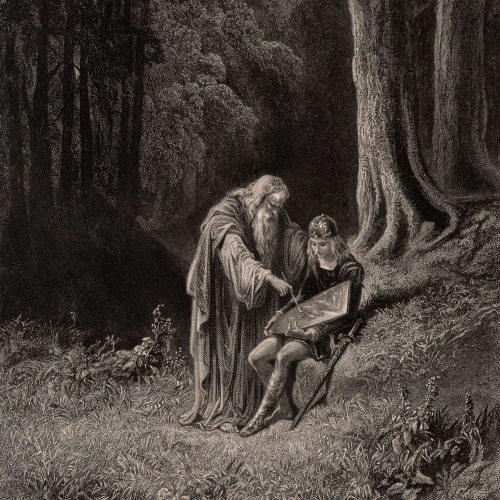
During the first half of the 13th century, two prose cycles formed themselves in France, each continuing Merlin’s story in a different way.
1) In the “Suite-Vulgate”, included within the greater cycle of the “Lancelot-Graal” or “Vulgate” (1215-1230), Merlin is the military advisor and strategist of Arthur in his battles against the barons that refuse his authority, then in his war against the Saxon, and finally in his feud against the emperor of Rome. Through Merlin, Arthur manages to marry Guenièvre, daughter of the king Laodegan, and he becomes the ruler in charge of the Round Table. But more importantly, it is here that Merlin encounters Viviane, the daughter of a lord named Dionas, at the edge of a fountain in the forest of Brocéliande. Wrapped around the tales of battles is a love story, during which Merlin allows Viviane to take away from him his magical knowledge. In order to keep Merlin all for herself, Viviane ends up capturing him within a “prison of air”, from where the prophet, now invisible, can still make his voice heard.
2) In the “Suite-Huth”, part of a cycle that was wrongly attributed to Robert de Boron, Merlin predicts the birth of Mordret, and the disasters caused by Balaain, the knight with two swords. It is Balaain that shall strike the “harmful blow” that will wound the king Pellehan and turn his kingdom in the “Terre Gaste”. Merlin is here much more involved in the adventures of the wandering knights than before. His role as an enchanter is put forward, as he is depicted commanding the wind, making the depiction of a dragon spit fire, open by magic the doors of a city, and preparing an enchanted bed that will remove from those that sleep within it their memory and their senses. The tale ends by the unfortunate love of Merlin and Viviane, which is a repetition of the love between Diana and Faunus. After bewitching Merlin, Viviane throws him into a vault whose stone cannot be removed. In his grave, Merlin screams one last time – and this last cry of the enchanter becomes the subject of an independent tale known as the “Conte du Brait”.
The first mention of Viviane is older than the “Suite-Vulgate”. She appears in the beginning of the “Lancelot” (or “Proper Lancelot”), under the name of Niniène, and she is depicted as a fairy of Bretagne that raised Lancelot in her wealthy domain hidden under a lake. Merlin appears here under a negative light. While his popularity is attested (it is said he was “so dreaded and so honored” by the people of Britany that all called him a “holy prophet” and common folks even called him a “god”), he is said to be “disloyal” and “deceiving” due to the nature of his father, and his knowledge is one of “perverse science”. The lady of the lake refuses his love out of wisdom, and she manages to trap him in “a cave within the dangerous forest of Darnantes”.
As such the character, that Robert de Boron tried to turn into the prophet of Christian knighthood, does not escape the ambiguity due to his composite origins, and which fits his genealogy, half-devil half-virgin. One can also see in his gift of shapeshifting a manifestation of his unstable personality, and of the contradiction of the several traits that compose him. This Proteus-like nature, certainly a remnant of the powers that were once attributed to the druids, allows Merlin to appear sometimes as a young man, sometimes as an old man, other times as a “woods-man/wild man”, and even as a great “branched stag”, as in the story of Grisandole (part of the “Suite-Vulgate”).
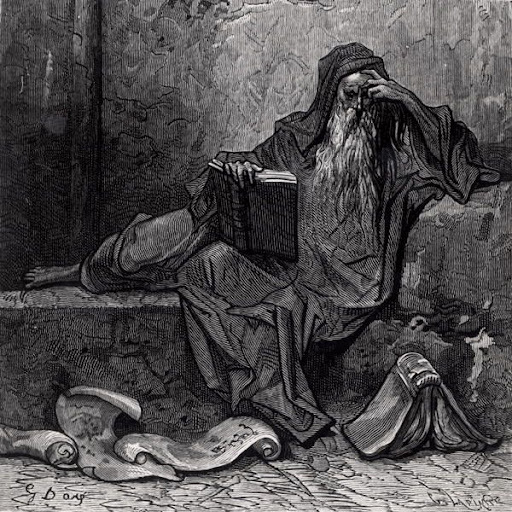
Built of successive additions, the tale of Merlin was reproduced, synthetized and translated, partially or entirely, by all the literatures of Europe until the end of the Middle-Ages. Even before 1250, the “Merlin” of Robert had been translated in the provençal language. The character also appears within numerous French verse romans of the 13th century: in “Fergus” (which places his lair in an isolated mountain), within “Le Chevalier aux Deux Epées”, within the “Roman du Hem”, within “Escanor”, within the “Roman de Silence” (where the Grisandole tale is found), and especially within “Claris et Laris”, which explains Merlin’s solitude by a crime he needs to expiate until his death. In the Prose Tristan (after 1240, Merlin takes care of Tristan, whose mother recently died, and gives him to a preceptor (just like he had done for Arthur in Robert de Boron’s text). Identified as a wizard, he builds a magical boat, the “nef de la joie”, for the king of Northomberlande. Outside of the knight-tales, a fairytale in verse of the beginning of the 12th century, “Du villain qui devient riche et puis pauvre”, also known as the “Dit de Merlin-merlot”, confirms the role among the “folk people” of Merlin as an embodiment of the supernatural.
The one that Dante called the “buon incantatore” was very popular in Italy, especially in relation to the work of Joachim of Flore. Among his apocryphal works there is an “Expositio Sibyllae et Merlini”. The tradition of Merlin as a prophet was enriched by a huge book of “Prophecies”, which mixed political predictions, sermons, and fictional stories. It was written in French between 1276 and 1279 by Venetian, probably a Franciscan. In the beginning of the 14th century, the Florentine Paolino Pieri mixed in his “Storia di Merlini” a tale of Merlin’s youth and the Italian translation of a part of the “Prophecies”. In 1480, Venice saw published six volumes of the “Historia di Merlino”, a great part also made of these prophecies supposedly made by Merlin.
In England, the “Merlin” of Robert and the “Suite-Vulgate” were recapped in a verse work known as “Arthour and Merlin” (1250-1300). Henri Lovelich gave an alternate version of this text in his “Merlin” (1430). A translation in Middle-English of the “Merlin-Vulgate” dates from the middle of the 15th century. Finally, sir Thomas Malory split the “Merlin” of Robert throughout the five first books of his “Morte d’Arthur”. This work, written in the prison of Newgate where Malory spent the last twenty years of his life, was printed in 1485 and constantly republished, and it ensured the fame of Arthur and Merlin within English-speaking countries.
In Germany, “Merlin und Seifrid de Ardemont”, by Albrecht von Scharfenberg (13th century) recaps Robert’s Merlin, with very important modifications (for example Pandragon and Uter are now the sons of Merlin). Other translations appeared in Holland. In Spain, the cycle of the pseudo-Robert de Boron was translated in the 14th century by the brother Juan Vivas, while the “Demanda del Sancto Grial” included a “Baladro del sabio Merlin”, derived from the lost “Brait de Merlin”. A Castilian version appeared at Burgos in 1498, and then another was published in Seville in 1535.
#merlin#merlin the enchanter#arthuriana#arthurian myth#arthurian literature#arthurian legend#medieval literature
24 notes
·
View notes
Text

Dust of dissonance
The grey aura
Drift of the pariah
Of the gathering
Hauling ley lines
Through the catacombs
Weaving day into day
Within the reliquary
The heart that beats
The heart that beats is out of reach
Carry the stones
Of lapidation
The burden outcast
Walk the barren vast
Dragging the barren past
Wandering the ever gloaming
The introspection
Light's miasma
Pilgrim
Eternity
The marching, the flayed
Pain of veils
Ossified
Desolation's sea
Sorrow, the path to the end
Faceless horizon
Where silence listens to silence
Rippling call, of the holy grail
Gorge the blood of god
Blood of god of self
Purge all poison
There is only dust
Humanity is gone
Graal - Ne Obliviscaris
65 notes
·
View notes
Text

The Leap Of Faith - Indiana Jones and the Last Crusade (1989)
#holy grail#grail#graal#art#indiana jones and the last crusade#indiana jones#crusader#knight#crusaders#knights#crusade#crusades#film#history#medieval#middle ages#christianity#christian#religion#religious
867 notes
·
View notes
Note
I have a question about COD mobile since you actually spend money on it. Is it worth it? Do you feel like it's a good idea to spend money on? I've been debating it for a while. There's stuff I wanna do, but I'm not sure if I should actually spend money on it you know?
Listen, I'm gonna be honest with you. Apart from certain guns (that in my opinion are a bit cheated out, but that's the raging bitch inside me talking), it's only skins, emotes and stuff like that.
Is it worth it? I'm a whore so having various daddy prices and ghosty and soap is holy Graal to me. I'm out here being a whore but not being paid, I'm paying others, cuz apparently I didn't understand the job.
So, it's worth it if you want all those pretty stuff. Otherwise, it doesn't really stop you from playing the game normally. Honestly you can enjoy the game without buying anything. Or be a broke bitch like me who spent +200€ on this game for some skins. But the one I got right now is dooopeee
Adding here that the clan is still taking recruits if y'all want to join!!
#fanfics#fanfiction#fanfic#simon ghost riley#simon riley#ghost cod#cod mw2#captain price#john soap mactavish#cod mobile#cod mwii#call of duty modern warfare#ghost call of duty#call of duty mobile
26 notes
·
View notes
Text




Les Contes du Saint Graal #6
10 notes
·
View notes
Note
As soon as I saw "putain" in your Arthur post I was like "ah, not Canadian then" lol
What is that show if you don't mind me asking?
Indeed, I am not Canadian but French (Salut :D).
I'm going to take a gander and guess you were talking about this post ?
This, dear anon, is Kaamelott, by Alexandre Astier.




You are following the adventures of King Arthur Pendragon, his knights and their quest for the Holy Graal.
However, things are not exactly easy, mostly because the knights are a bunch dumdumbs.


The first seasons of the show have short comedic episodes and later on they get bigger and the story actually starts to take the shape of an Arthurian Legend.
We got the movie in 2021 (we…waited 10 years to finally get it….It's in 3 parts…Send help)
This is the only French show I'd recommend to an English crowd to this day.
It got some good french humor, sneaky symbolism, feels, like a LOT of FEELS, movie refs and good boys (Perceval is baby)









(See ? Order of the King, Perceval is baby.)
(Credits for the gifs all go to @dagonet, the fandom is forever thankful)
48 notes
·
View notes
Text
Okay, so I read this book years ago but I am hoping that somebody on here will know it because I am trying to find it again. It was an arthurian retelling, I am pretty sure.
So it had the knights of the roundtable, the quest for the holy grail. Lancelot being in love with Guinevere and a scene between them lying naked on a bed with a sword in between them, trying to do their best to remain loyal to Arthur and their vows. There is also a woman named Elaine, I think, who was in love with Lance and either tried to trick him or actually tricked him into bedding her by taking up a guise of being Guinevere.
And there is a scene where I think Lancelot went off to find the holy grail and got lost along the way, my memory is pretty hazey about where he was going and how he got here, but he was trapped somewhere. And there was an illusion of Guinevere picking flowers, he memorised the way 'she' moved and picked flowers with her and idk. That's pretty much all I remember. And also maybe Mordred was in it and I think the cover might have been grey + it could have been part of a book series. 😅
(Mystery solved thanks to @ distinguished-bog-snail, as seen in the replies of this post 💗. The scenes above are from 2 books from the Graal book series by Christian de Montella)
32 notes
·
View notes
Text
Day 15

Liber Cheth
vel
Vallum Abiegni
sub figurâ CLVI
A∴A∴ Publication in Class A
1.
This is the secret of the Holy Graal, that is the sacred vessel of our Lady the Scarlet Woman, Babalon the Mother of Abominations, the bride of Chaos, that rideth upon our Lord the Beast.
2.
Thou shalt drain out thy blood that is thy life into the golden cup of her fornications.
3.
Thou shalt mingle thy life with the universal life. Thou shalt keep not back one drop.
4.
Then shall thy brain be dumb, and thy heart beat no more, and all thy life shall go from thee; and thou shalt be cast out upon the midden, and the birds of the air shall feast upon thy flesh, and thy bones shall whiten in the sun.
5.
Then shall the winds gather themselves together, and bear thee up as it were a little heap of dust in a sheet that hath four corners, and they shall give it unto the guardians of the abyss.
6.
And because there is no life therein, the guardians of the abyss shall bid the angels of the winds pass by. And the angels shall lay thy dust in the City of the Pyramids, and the name thereof shall be no more.
7.
Now therefore that thou mayest achieve this ritual of the Holy Graal, do thou divest thyself of all thy goods.
8.
Thou hast wealth; give it unto them that have need thereof, yet no desire toward it.
9.
Thou hast health; slay thyself in the fervour of thine abandonment unto Our Lady. Let thy flesh hang loose upon thy bones, and thine eyes glare with thy quenchless lust unto the Infinite, with thy passion for the Unknown, for Her that is beyond Knowledge the accursèd one.
10.
Thou hast love; tear thy mother from thine heart, and spit in the face of thy father. Let thy foot trample the belly of thy wife, and let the babe at her breast be the prey of dogs and vultures.
11.
For if thou dost not this with thy will, then shall We do this despite thy will. So that thou attain to the Sacrament of the Graal in the Chapel of Abominations.
12.
And behold! if by stealth thou keep unto thyself one thought of thine, then shalt thou be cast out into the abyss for ever; and thou shalt be the lonely one, the eater of dung, the afflicted in the Day of Be-with-Us.
13.
Yea! verily this is the Truth, this is the Truth, this is the Truth. Unto thee shall be granted joy and health and wealth and wisdom when thou art no longer thou.
14.
Then shall every gain be a new sacrament, and it shall not defile thee; thou shalt revel with the wanton in the market-place, and the virgins shall fling roses upon thee, and the merchants bend their knees and bring thee gold and spices. Also young boys shall pour wonderful wines for thee, and the singers and the dancers shall sing and dance for thee.
15.
Yet shalt thou not be therein, for thou shalt be forgotten, dust lost in dust.
16.
Nor shall the æon itself avail thee in this; for from the dust shall a white ash be prepared by Hermes the Invisible.
17.
And this is the wrath of God, that these things should be thus.
18.
And this is the grace of God, that these things should be thus.
19.
Wherefore I charge you that ye come unto me in the Beginning; for if ye take but one step in this Path, ye must arrive inevitably at the end thereof.
20.
This Path is beyond Life and Death; it is also beyond Love; but that ye know not, for ye know not Love.
21.
And the end thereof is known not even unto Our Lady or to the Beast whereon She rideth; nor unto the Virgin her daughter nor unto Chaos her lawful Lord; but unto the Crowned Child is it known? It is not known if it be known.
22.
Therefore unto Hadit and unto Nuit be the glory in the End and the Beginning; yea, in the End and the Beginning
art credits: https://www.artstation.com/artwork/DANmBy
9 notes
·
View notes